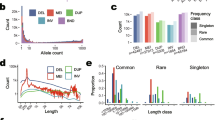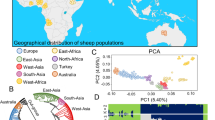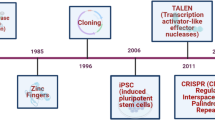Abstract
Molecular markers based on retrotransposon insertion polymorphisms (RTIPs) have great potential in studies of animal genetics and breeding. In this study, L1 RTIP markers were developed and evaluated by using microsatellite primers combined with L1 specific primers, and were further evaluated in four Chinese and three imported domestic pig breeds. Eight L1RTIP markers were obtained, and uneven distribution was observed among these breeds, with the Sujiang breed exhibiting the highest level of polymorphism with seven polymorphic sites, followed by Jiangquhai, Meishan, and Duroc with six, four, and four polymorphic sites, respectively. Both Landrace and Yorkshire pigs exhibited three polymorphic sites, while Chinese inbred Bama pig showed the lowest level of polymorphism with only one polymorphic site. Three polymorphic makers (L1-31-2, L1-31-5, and L1-31-11) were strongly associated with the economic traits in 462 Yorkshire pigs, with the L1-31-5+ genotype females had a significantly greater alive litter size (11.44 ± 2.80) compared with pigs with the L1-31-5– genotype (9.96 ± 2.89) (P < 0.05). L1-31-11– genotype pigs had significantly younger age at 100 kg of body weight (160.20 ± 10.26 days) than the L1-31-11+counter parts (162.47 ± 9.71 days) (P < 0.05). In summary, we demonstrated that it is feasible to develop markers based on L1 RTIP sin the pig, and these markers may have greater potential in the application of pig genetics and breeding compared to non-selective conventional breeding.


Similar content being viewed by others
REFERENCES
Goodier, J.L. and Kazazian, H.H., Retrotransposons revisited: the restraint and rehabilitation of parasites, Cell, 2008, vol. 135, no. 1, p. 23.
Lindblad-Toh, K., Wade, C.M., Mikkelsen, T.S., et al., Genome sequence, comparative analysis and haplotype structure of the domestic dog, Nature, 2005, vol. 438, no. 7069, pp. 803—819.
Lander, E.S., Linton, L.M., and Birren, B., International Human Genome Sequencing Consortium, Nature, 2001, vol. 412, no. 412, pp. 565—566.
Groenen, M.A., Archibald, A.L., Uenishi, H., et al., Analyses of pig genomes provide insight into porcine demography and evolution, Nature, 2012, vol. 491, no. 7424, pp. 393—398.
Gentles, A.J., Wakefield, M.J., Kohany, O., et al., Evolutionary dynamics of transposable elements in the short-tailed opossum Monodelphis domestica,Genome Res., 2007, vol. 17, no. 7, pp. 992—1004.
Finnegan, D.J., Eukaryotic transposable elements and genome evolution, Trends Genet., 1989, vol. 5, no. C, pp. 103—107.
Eickbush, T.H. and Malik, H.S., Origins and Evolution of Retrotransposons, 2002.
Waterston, R.H., Lindblad-Toh, K., Birney, E., et al., Initial sequencing and comparative analysis of the mouse genome, Nature, 2002, vol. 420, no. 6915, pp. 520—562.
Lander, E.S., Linton, L.M., Birren, B., et al., Initial sequencing and analysis of the human genome, Nature, 2001, vol. 409, no. 6822, pp. 860—921.
Deberardinis, R.J. and Al, E., Rapid amplification of a retrotransposon subfamily is evolving the mouse genome, Nat. Genet., 1998, vol. 20, no. 3, pp. 288—290.
Mandal, P.K. and Kazazian, H.H., Jr., SnapShot: vertebrate transposons, Cell, 2008, vol. 135, no. 1, p. 192.
Sassaman, D.M., Dombroski, B.A., Moran, J.V., et al., Many human L1 elements are capable of retrotransposition, Nat. Genet.,1997, vol. 16, no. 1, p. 37.
Flavell, A.J., Dunbar, E., Anderson, R., et al., Ty1-copia group retrotransposons are ubiquitous and heterogeneous in higher plants, Nucleic Acids Res., 1992, vol. 20, no. 14, pp. 3639—3644.
Hancks, D.C., and Kazazian, H.H., Jr., Active human retrotransposons: variation and disease, Curr. Opin. Genet. Dev., 2012, vol. 22, no. 3, pp. 191—203.
Belancio, V.P., Hedges, D.J. and Deininger, P., Mammalian non-LTR retrotransposons: for better or worse, in sickness and in health, Genome Res., 2008, vol. 18, no. 3, p. 343.
Chen, J.M., Stenson, P.D., Cooper, D.N. and Férec, C., A systematic analysis of LINE-1 endonuclease-dependent retrotranspositional events causing human genetic disease, Hum. Genet., 2005, vol. 117, no. 5, pp. 411—427.
Hancks, D.C. and Kazazian, H.H., Jr., Roles for retrotransposon insertions in human disease, Mob. DNA, 2016, vol. 7, no. 1, p. 9.
Lohmueller, K.E., Indap, A.R., Schmidt, S., et al., Proportionally more deleterious genetic variation in European than in African populations, Nature, 2008, vol. 451, no. 7181, pp. 994—997.
Ewing, A.D., Kazazian, H.H., Ewing, A.D., et al., Whole-genome resequencing allows detection of many rare LINE-1 insertion alleles in humans, Genome Res., 2011, vol. 21, no. 6, p. 985.
Jakobsson, M., Scholz, S.W., Scheet, P., et al., Genotype, haplotype and copy-number variation in worldwide human populations, Nature, 2008, vol. 451, no. 7181, p. 998.
Tishkoff, S.A. and Williams, S.M., Genetic analysis of African populations: human evolution and complex disease, Nat. Rev. Genet., 2002, vol. 3, no. 8, pp. 611—621.
Schulman, A.H., IRAP and REMAP for retrotransposon-based genotyping and fingerprinting, Nat. Protoc., 2006, vol. 1, no. 5, p. 2478.
De-Lin, Wang, Xiao-Ying, Xiao-Hong, et al., Effects of back fat, growth rate, and age at first mating on Yorkshire and Landrace sow longevity in China, J. Integr. Agric., 2016, vol. 15, no. 12, pp. 2809—2818.
Kalendar, R., Flavell, A.J., Ellis, T.H., et al., Analysis of plant diversity with retrotransposon-based molecular markers, Heredity (Edinbourgh), 2010, vol. 106, no. 4, p. 520.
Jing, R., Vershinin, A., Grzebyta, J., et al., The genetic diversity and evolution of field pea (Pisum) studied by high throughput retrotransposon based insertion polymorphism (RBIP) marker analysis, BMC Evol. Biol., 2010, vol. 10, no. 1, p. 44.
Mandoulakani, B.A., Piri, Y., Darvishzadeh, R., et al., Retroelement insertional polymorphism and genetic diversity in Medicago sativa populations revealed by IRAP and REMAP markers, Plant Mol. Biol. Rep., 2012, vol. 30, no. 2, pp. 286—296.
Tam, S.M., Mhiri, C., Vogelaar, A., et al., Comparative analyses of genetic diversities within tomato and pepper collections detected by retrotransposon-based SSAP, AFLP and SSR, Theor. Appl. Genet., 2005, vol. 110, no. 5, pp. 819—831.
Yamashita, H. and Tahara, M., A LINE-type retrotransposon active in meristem stem cells causes heritable transpositions in the sweet potato genome, Plant Mol. Biol., 2006, vol. 61, nos. 1—2, pp. 79—84.
Chessa, B., Kao, R., and Palmarini, M., Revealing the History of Sheep Domestication Using Retrovirus Integrations, 2009.
Kamath, P.L., Elleder, D., Bao, L., et al., The population history of endogenous retroviruses in mule deer (Odocoileus hemionus), J. Hered., 2014, vol. 105, no. 2, p. 173.
Lee, J., Mun, S., Kim, D.H., et al., Chicken (Gallus gallus) endogenous retrovirus generates genomic variations in the chicken genome, Mob. DNA, 2017, vol. 8, no. 1, p. 2.
Levin, H.L. and Moran, J.V., Dynamic interactions between transposable elements and their hosts, Nat. Rev. Genet., 2011, vol. 12, no. 9, pp. 615—627.
Sironen, A., Vilkki, J., Bendixen, C., et al., Infertile Finnish Yorkshire boars carry a full-length LINE-1 retrotransposon within the KPL2 gene, Mol. Genet. Genomics, 2007, vol. 278, no. 4, pp. 385—391.
Mikawa, S., Sato, S., Nii, M., et al., Identification of a second gene associated with variation in vertebral number in domestic pigs, BMC Genet., 2011, vol. 12, no. 1, p. 5.
Hedlund, M., Ng, E., Varki, A., and Varki, N.M., Alpha 2-6-linked sialic acids on N-glycans modulate carcinoma differentiation in vivo, Cancer Res., 2008, vol. 68, no. 2, p. 388.
Wang, Y.C., Stein, J.W., Lynch, C.L., et al., Glycosyltransferase ST6GAL1 contributes to the regulation of pluripotency in human pluripotent stem cells, Sci. Rep., 2015, vol. 5, p. 13317.
Wanichnopparat, W., Suwanwongse, K., Pin-On, P., et al., Genes associated with the cis-regulatory functions of intragenic LINE-1 elements, BMC Genomics, 2013, vol. 14, no. 1, p. 205.
Funding
This work was supported by the Natural Science Foundation of China (31572364 and 31872977); the Priority Academic Program Development of Jiangsu Higher Education Institutions; the National Development and Reform Commission Special Breeding Projects; and the Postgraduate Research and Practical Innovation Program of Jiangsu Province (XKYCX17_058).
Author information
Authors and Affiliations
Contributions
W. Wang and C. Chen have contributed equally to this work.
Corresponding author
Ethics declarations
Conflict of interest. The authors declare no competing financial interests.
Statement on the welfare of animals. Animal care and use was approved by the University of Yangzhou Animal Care and Use Committee.
Supplementary material
Rights and permissions
About this article
Cite this article
Wang, W., Chen, C., Wang, X. et al. Development of Molecular Markers Based on the L1 Retrotransposon Insertion Polymorphisms in Pigs (Sus scrofa) and Their Association with Economic Traits. Russ J Genet 56, 183–191 (2020). https://doi.org/10.1134/S1022795420020131
Received:
Revised:
Accepted:
Published:
Issue Date:
DOI: https://doi.org/10.1134/S1022795420020131




